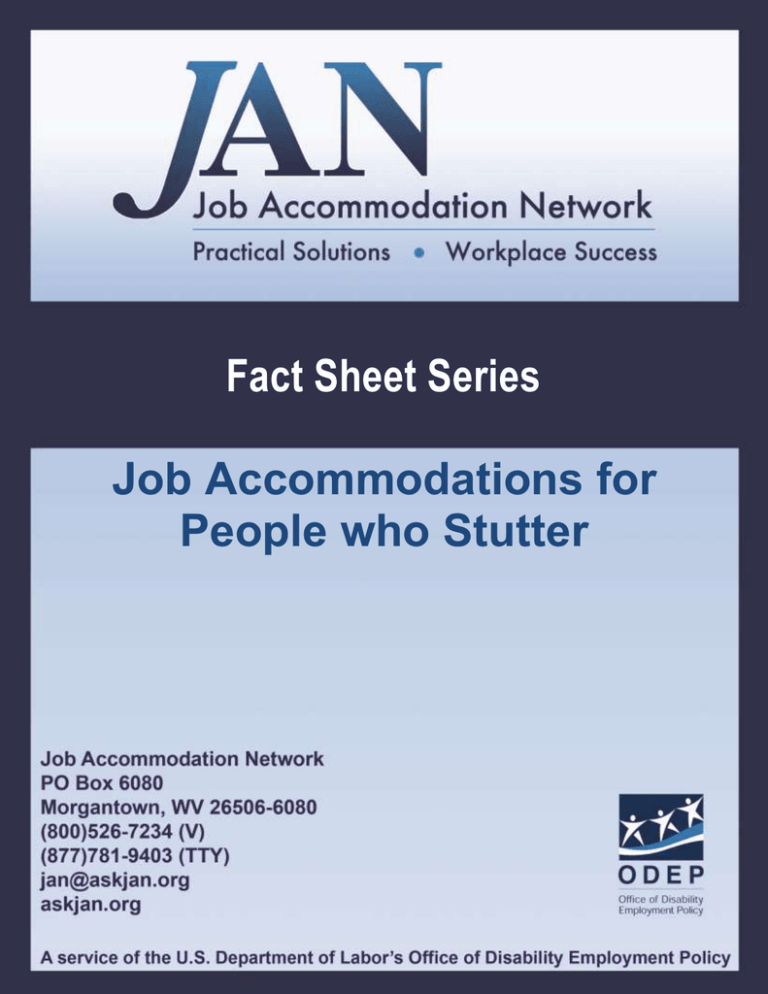Job Accommodations for People who Stutter Fact Sheet Series
advertisement

Fact Sheet Series Job Accommodations for People who Stutter JAN’S ACCOMMODATION FACT SHEET SERIES JOB ACCOMMODATIONS FOR PEOPLE WHO STUTTER According to the Stuttering Foundation of America (SFA), over three million people in the United States stutter. Males are affected by stuttering four times more than females. When someone stutters the flow of speech can be interrupted by repetitions, prolongations, or periods where no sound is produced during the person’s effort to communicate. The person may also exhibit unusual facial and body movements while trying to speak. There is no single cause of stuttering but current research is focusing on neurological causes. Stuttering is not caused by an emotional or nervous disorder. Some individuals who stutter can benefit from stuttering therapy and the use of fluency aids. The National Stuttering Association (NSA) indicates that adults who stutter may benefit from stuttering therapy to help their speech but that on-going maintenance may be needed to manage continued fluency. An article written by William D. Parry, Chair of the NSA Advocacy Committee, states “Of the many obstacles faced by people who stutter perhaps the most devastating is discrimination in employment and educational opportunities.” Parry also notes that people who stutter are subject to negative stereotypes that prevent them from obtaining employment and promotional opportunities. According to Parry, common stereotypes include, “the widely accepted impression that stutterers are nervous, shy, quiet, selfconscious, withdrawn, tense, anxious, fearful, reticent, and guarded.” Individuals who stutter can be highly qualified and capable workers if provided the chance to get their foot in the door. People who stutter are encouraged to talk about their stuttering with their employers to dispel stereotypes. Information about workplace accommodations may also be helpful. The following is a brief overview of some of the accommodations that might be useful for people who stutter. For a more in depth discussion, access JAN's publications at http://askjan.org/media/atoz.htm. To discuss an accommodation situation with a consultant, contact JAN directly. Application and Interview-Information for the Employer: Be patient and listen Do not complete words or sentences for the individual Maintain conversational eye contact and focus on the content of communication rather than the delivery of the communication Relax and communicate as you would normally Provide interview questions in advance if possible to allow the individual time to prepare and deliver responses effectively Consider offering a personal interview as an alternative to a phone interview Become knowledgeable about stuttering 2 Application and Interview-Information for the Individual: Talk with the employer about stuttering and how it may impact job performance and provide suggestions for accommodations that may alleviate performance concerns (organizations such as the SFA and the NSA suggest that people who stutter should be open about their speaking abilities) Provide an informative cover letter and resume or vita to be used as marketing tools; market yourself and sell your abilities Be prepared for the interview by researching typical interview questions, preparing answers, and rehearsing prior to interview Request a personal interview if a telephone interview is scheduled but a personal interview would be more effective Try to use words that you are comfortable with; use words and phrases that are easier to say if said often On the Job: Talk with co-workers and clients about stuttering to educate them and ease their anxiety about communicating Try to use words that do not present barriers to communication Try the following if using the telephone is difficult: When making calls, be prepared; know what needs to be said before dialing and write the main points down; use a script when applicable Rehearse the call with someone else Do not procrastinate; procrastination will only prolong anxiety and make the situation more stressful Answer telephone calls when ready and focus on the call, not on distractions around you Be prepared with easy ways to answer the telephone: “Hello this is Jim,” “Mary speaking,” “Good morning/afternoon,” etc. Practice using the telephone as often as possible Be prepared and be concise when speaking in public and get right to the point Use electronic communication options such as e-mail and instant messaging Use fluency aids if effective and seek out therapy options Be confident (SFA states that “Fluent speech breeds confidence, and confidence breeds fluent speech”) 3 Resources Specifically for People who Stutter American Speech Language Hearing Association 2200 Research Boulevard Rockville, MD 20850-3289 Toll Free: (800)638-8255 Direct: (301)296-5700 Fax: (301)296-8580 actioncenter@asha.org http://www.asha.org National Stuttering Association 119 W. 40th Street, 14th Floor New York, NY 10018 Toll Free: (800)937-8888 Direct: (212)944-4050 Fax: (212)944-8244 info@WeStutter.org http://www.nsastutter.org NIDCD Information Clearinghouse 1 Communication Avenue Bethesda, MD 20892-3456 Toll-free Voice: (800) 241-1044 Toll-free TTY: (800) 241-1055 Fax: (301) 770-8977 nidcdinfo@nidcd.nih.gov http://www.nidcd.nih.gov/StaticResources/Forms/AllItems.aspx?RootFolder=%2fStaticR esources%2fhealth%2fvoice&FolderCTID=&View=%7b4EF80C33%2d9F14%2d4E35% 2d80C6%2d4303F11CB3C8%7d Specialty Board on Fluency Disorders 2560 RCA Blvd., Suite 106 Palm Beach Gardens, FL 33410 Fax: 561-627-2204 http://www.stutteringspecialists.org/ Stuttering Foundation of America 3100 Walnut Grove Road Suite 603 Memphis, TN 38111 Toll Free: (800)992-9392 Direct: (901)452-7343 Fax: (901)452-3931 info@stutteringhelp.org http://www.stutteringhelp.org Updated 3/23/10. 4 This document was developed by the Job Accommodation Network, funded by a contract agreement from the U.S. Department of Labor, Office of Disability Employment Policy (DOL079RP20426). The opinions expressed herein do not necessarily reflect the position or policy of the U.S. Department of Labor. Nor does mention of trade names, commercial products, or organizations imply endorsement by the U.S. Department of Labor. 5
